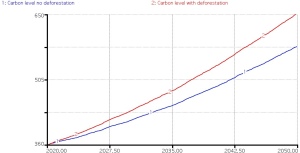The first Dummies Guide to Climate Change laid out the basic structure for the storing of CO2 in the atmosphere. The article then described the dynamics of the relationship between the inflows of CO2 into the atmosphere, the outflows through the carbon sinks and the levels of CO2 that accumulate in the atmosphere.
This simple model is sometimes called a bathtub model. The inflow is the tap, the outflow is the plughole and the amount of water in the bathtub represents the level or accumulation.
The purpose of these articles is to provide simple models of complex structures and dynamics. To do this,The models built at a high level of aggregation. In this model, the forests that are cut down are replanted as regenerating forests. This is a simplification of the land use that follows deforestation. However, it serves to illustrate the more general principle of the long-term effect of deforestation
The second Dummies Guide to Climate Change drills down into the functioning of the outflow by examining dynamics of carbon storage capacity and deforestation. This sub-model shows the process where forests are cut down (deforestation) and replanted as regenerating forests. Over time, the regenerating forests are restored to their original state. However, there is a decades-long delay before this happens.
The important dynamic here is the impact on the capacity of the land-based carbon sink to absorb CO2. The regenerating forests have some capacity but nowhere near the capacity of the mature forests that have been cut down. The consequence of deforestation is a decline in overall carbon sink capacity.
It is generally acknowledged that the world has lost close to 50% of its forests in the last 50 years and that if deforestation continues at its present rate, there may be very few forests left within 50 years. In the last few years, the rate of increase in deforestation has become greater than the rate of increase in population. This is because of the rising affluence of global middle-class and its demand for plant-based products, particularly palm oil.
Deforestation has a double effect on the carbon sink. The first effect is that the burning rain forests increases the CO2 in the atmosphere. The second is that the decreased area of forests reduces the capacity of the carbon sink.
This double effect is amplified because it represents an increase in the inflow and a decrease in the outflow leading to a much higher level of CO2 in the atmosphere.
It is clear from the model that the impact of deforestation is significant because of its impact on both the inflows and outflows of the system. It is also clear that action on deforestation will be necessary to avoid catastrophic increases in global CO2 levels. It is also clear from the model that even if the forests are replaced, the delay while they grow means that carbon continues to build up in the atmosphere. It is also clear from the previous model that increasing the landmass and deforestation by a massive 20% only has a minor effect on CO2 levels in the atmosphere.





